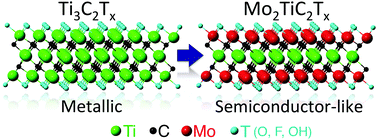Control of electronic properties of 2D carbides (MXenes) by manipulating their transition metal layers†
Abstract
In this study, a transition from metallic to semiconducting-like behavior has been demonstrated in two-dimensional (2D) transition metal carbides by replacing titanium with molybdenum in the outer transition metal (M) layers of M3C2 and M4C3 MXenes. The MXene structure consists of n + 1 layers of near-close packed M layers with C or N occupying the octahedral site between them in an [MX]nM arrangement. Recently, two new families of ordered 2D double transition metal carbides MXenes were discovered, M′2M′′C2 and M′2M′′2C3 – where M′ and M′′ are two different early transition metals, such as Mo, Cr, Ta, Nb, V, and Ti. The M′ atoms only occupy the outer layers and the M′′ atoms fill the middle layers. In other words, M′ atomic layers sandwich the middle M′′–C layers. Using X-ray atomic pair distribution function (PDF) analysis on Mo2TiC2 and Mo2Ti2C3 MXenes, we present the first quantitative analysis of structures of these novel materials and experimentally confirm that Mo atoms are in the outer layers of the [MC]nM structures. The electronic properties of these Mo-containing MXenes are compared with their Ti3C2 counterparts, and are found to be no longer metallic-like conductors; instead the resistance increases mildly with decreasing temperatures. Density functional theory (DFT) calculations suggest that OH terminated Mo–Ti MXenes are semiconductors with narrow band gaps. Measurements of the temperature dependencies of conductivities and magnetoresistances have confirmed that Mo2TiC2Tx exhibits semiconductor-like transport behavior, while Ti3C2Tx is a metal. This finding opens new avenues for the control of the electronic and optical applications of MXenes and for exploring new applications, in which semiconducting properties are required.

- This article is part of the themed collection: Nanoscale Horizons 10th anniversary regional spotlight collection: The Americas

 Please wait while we load your content...
Please wait while we load your content...